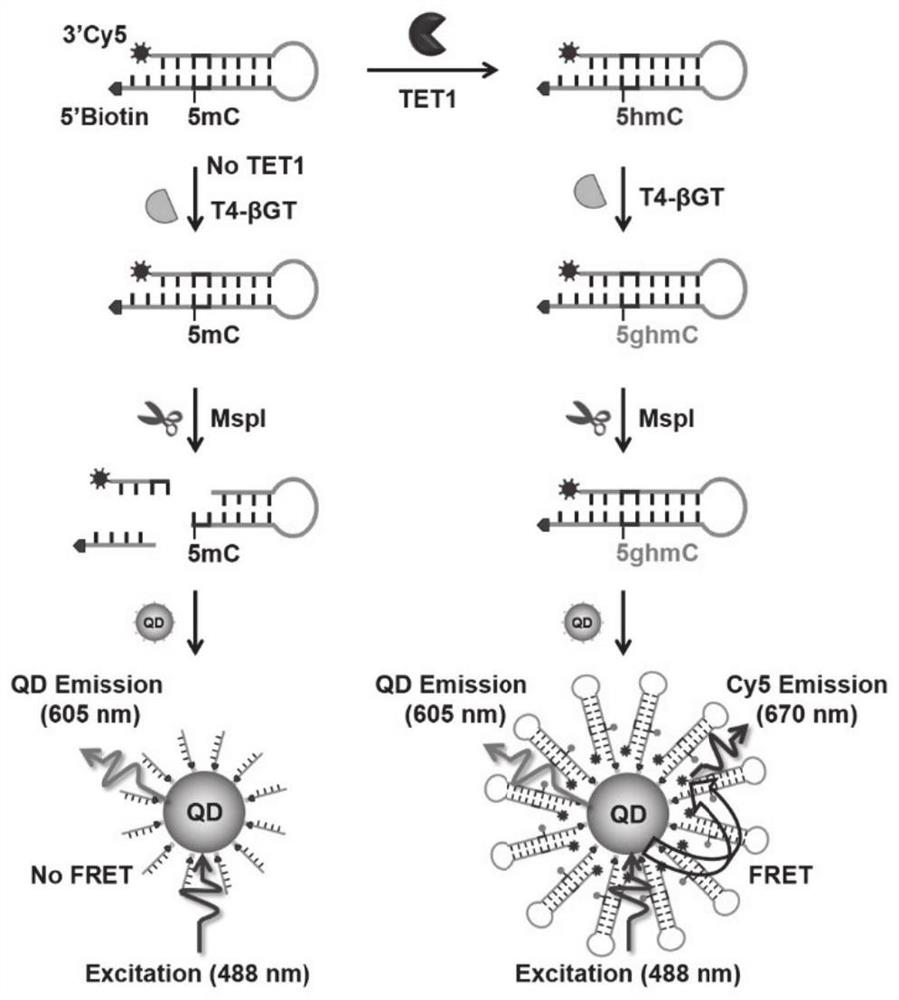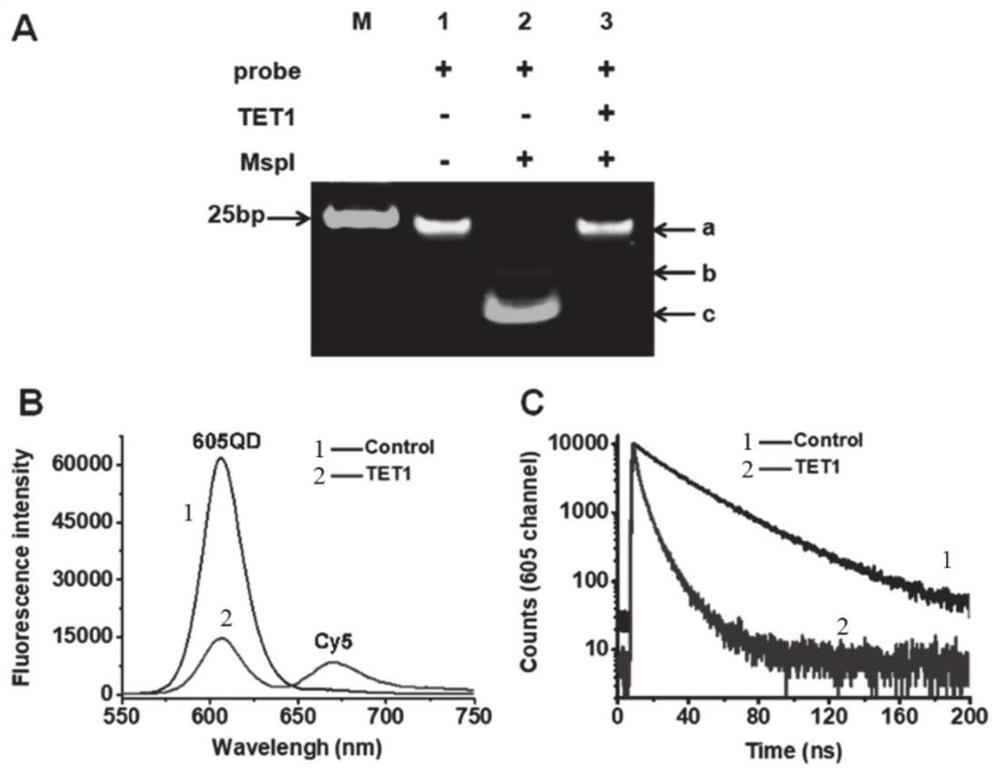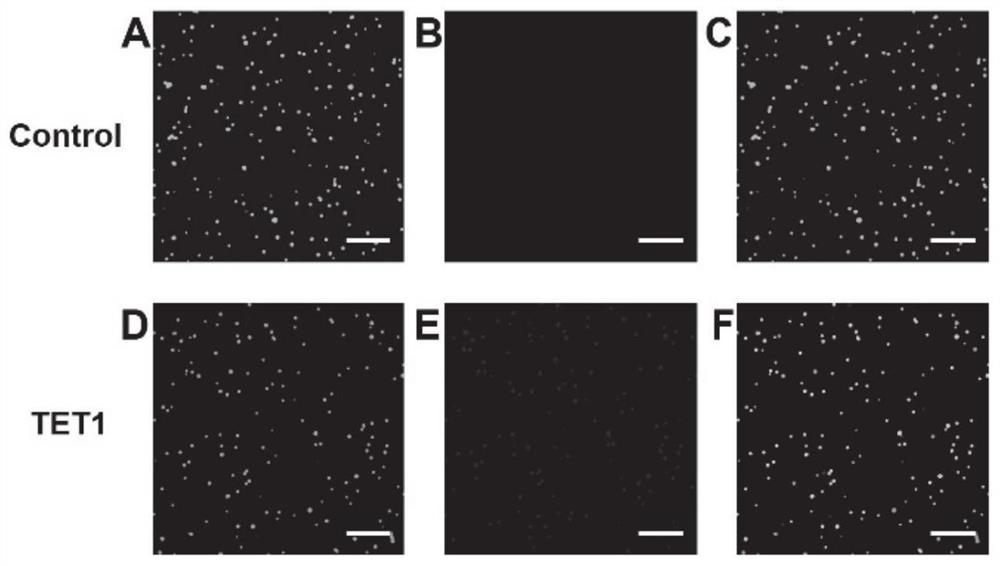A nanosensor for detecting DNA hydroxylase tet1 and its detection method and application
A nano-sensor and detection method technology, applied in the field of analysis and testing, can solve the problems of low sensitivity, time-consuming separation operation, large TET1-specific antibody, etc., and achieve the effect of sensitive detection
- Summary
- Abstract
- Description
- Claims
- Application Information
AI Technical Summary
Problems solved by technology
Method used
Image
Examples
Embodiment approach
[0032] A typical embodiment of the present invention provides a nanosensor for detecting DNA hydroxylase TET1, including a hairpin probe, T4 phage β-glucosyltransferase, endonuclease, and quantum dots;
[0033] The hairpin probe is a single-stranded DNA capable of forming a stem-loop structure, one end of the hairpin probe is connected to a fluorescent agent, and the other end can be connected with a quantum dot, and the stem region forming the stem-loop structure contains an endonuclease. A recognition and cleavage site containing 5-methylcytosine;
[0034] Quantum dots and fluorescent agents can cooperate to generate fluorescence resonance energy transfer.
[0035] In some embodiments, the fluorescent agent is Cy5 and the quantum dots are 605QD.
[0036] In some embodiments, the hairpin probes are linked to the quantum dots via biotin-streptavidin. Further, the hairpin probe was linked to biotin, and the surface of the quantum dots was coated with streptavidin.
[0037] I...
Embodiment
[0063] Determination of TET1: First, the detection probe was mixed with buffer A (5 mM MgCl 2 , 10 mM Tris-HCl, pH 8.0), incubated at 95 °C for 5 min, and slowly cooled to room temperature. Then, in a solution containing 50 mM HEPES, 50 mM NaCl, 75 μM Fe(NH 4 ) 2 (SO 4 ) 2 , 2mM ascorbic acid, 2.5mM DTT and 1mM α-KG were added to the reaction solution of 144nM detection probe and different concentrations of TET1, and reacted at 37°C for 30min. Third, the reaction product was mixed with 40 μM uridine diphosphate glucose (UDP-glucose) and 3U T4 bacteriophage β-glucosyltransferase (T4-βGT) and buffer B (50 mM potassium acetate, 20 mM Tris-Ac, 10 mM magnesium acetate, 1mM DTT, pH 7.9) to form a reaction solution, and incubated at 37°C for 2h. Subsequently, the glycosylation product was combined with 30 U MspI and buffer C (10 mM magnesium acetate, 20 mM Tris-Ac, 50 mM potassium acetate, 0.1 mg / mL BSA, pH 7.9) to form a reaction solution, and digested at 37 °C for 2 h. Finall...
PUM
 Login to View More
Login to View More Abstract
Description
Claims
Application Information
 Login to View More
Login to View More - R&D
- Intellectual Property
- Life Sciences
- Materials
- Tech Scout
- Unparalleled Data Quality
- Higher Quality Content
- 60% Fewer Hallucinations
Browse by: Latest US Patents, China's latest patents, Technical Efficacy Thesaurus, Application Domain, Technology Topic, Popular Technical Reports.
© 2025 PatSnap. All rights reserved.Legal|Privacy policy|Modern Slavery Act Transparency Statement|Sitemap|About US| Contact US: help@patsnap.com



